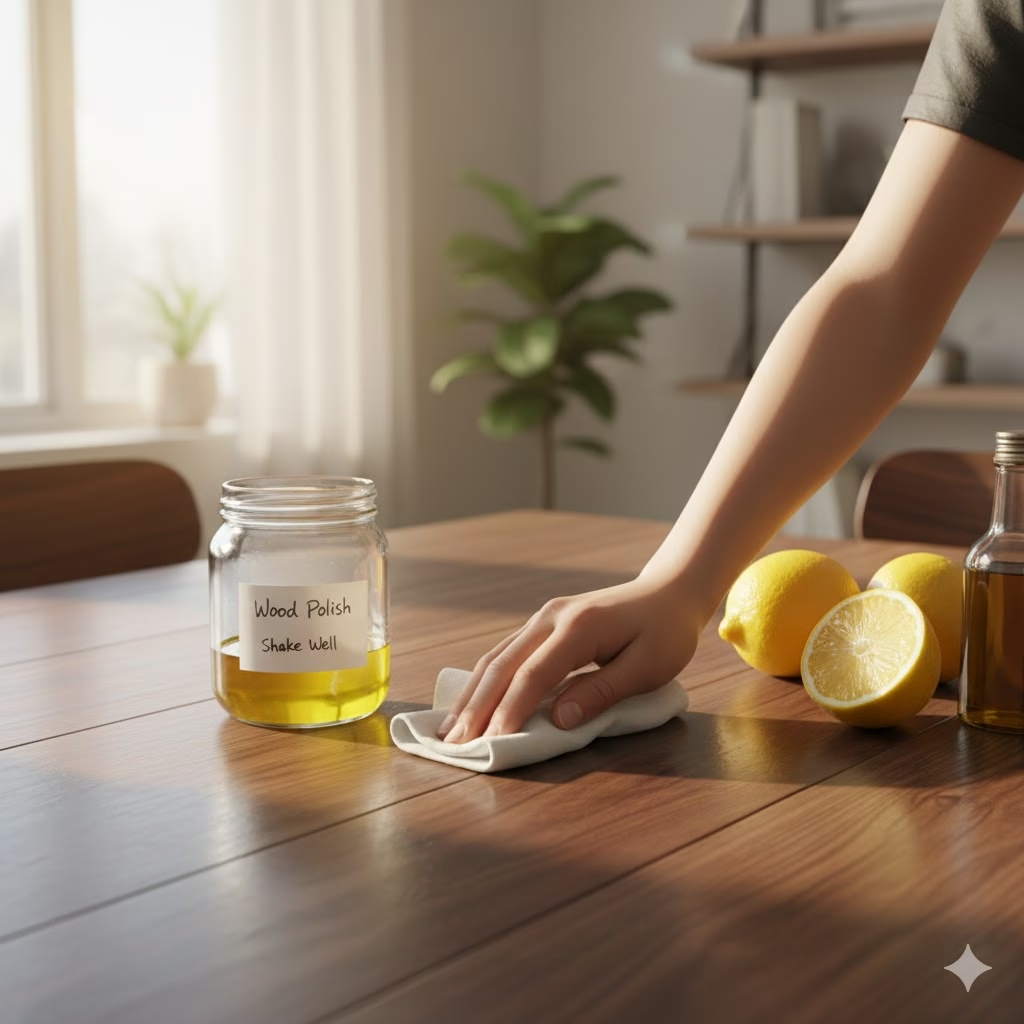
Living without gardens doesn’t mean you can’t be a zero waste gardener; it just means you have to be smarter about your resources. Discover how to transform kitchen scraps and food waste into potent, all-natural Fruit and Veggie Fertilizers. This simple shift turns every urban window sill into a sustainable, thriving green space.
Do you want to live a zero waste life? You can start right now with your houseplants! Most people throw away fruit peels and veggie skins every day. But these scraps are free, natural food for your plants. This is true zero-waste gardening for anyone living without gardens.

This simple process turns your kitchen waste into powerful Fruit and Veggie Fertilizers. It works well for your plants, saves you money, and helps the planet by cutting down on trash.
This is more than just throwing things out. It’s about being mindful of the resources you use. When you feed your plants with scraps, you close the loop: the food you buy helps the food you grow.
But remember the rule: Don’t just put a banana peel in the dirt! You must prepare the scraps first.
Why You Must Prepare the Scraps for Fruit and Veggie Fertilizers
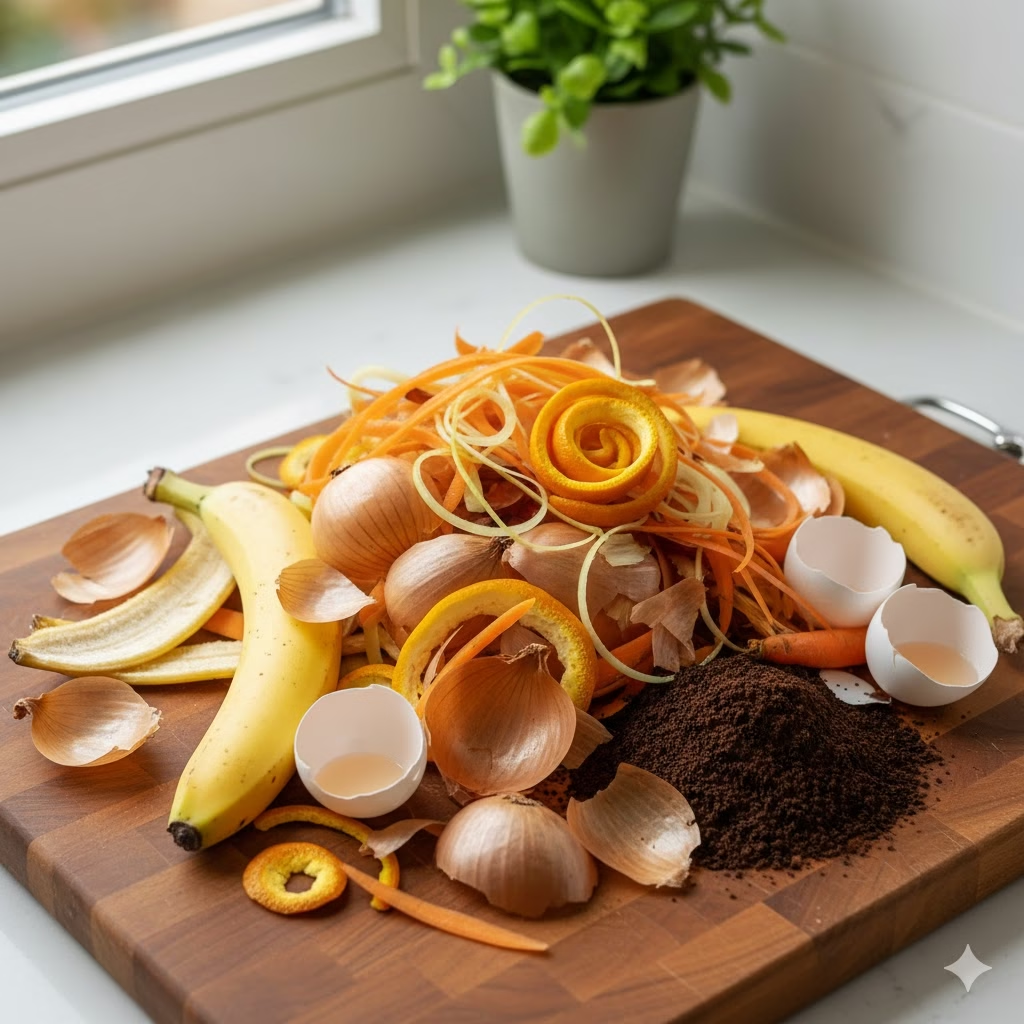
It’s okay to bury raw food scraps outside. Gardens have lots of dirt, space, and living organisms to break things down fast. But your indoor plants live in small, closed pots. Putting raw scraps directly into pots causes big problems:
1. The Pest Problem with Fruit and Veggie Fertilizers
Raw food attracts bugs like fungus gnats, fruit flies, and other small, unwelcome insects. They are drawn to the rotting food in the moist soil. Once they move in, they can spread throughout all your indoor plants.

2. The Mold and Smell Problem with Fruit and Veggie Fertilizers
In a small pot, food rots very slowly because there isn’t enough air (oxygen). This is called anaerobic decay. This process makes bad smells and causes mold to grow on the surface and under the soil. This mold can hurt your plant’s roots.
3. The Slow Feeding Problem
Decomposition takes a long time indoors. Your soil doesn’t have all the bacteria and worms that an outdoor garden has. This means the nutrients stay locked inside the peels for months. Your plant won’t get the food it needs when it needs it.
4. The Root Danger Problem (Salts and Acidity), with Fruit and Veggie Fertilizers
As food scraps break down, they can create concentrated salts or acids. In a small pot, these compounds build up fast. This sudden spike can cause nutrient burn (salt burn) on the roots, which quickly damages or kills the plant. Prepared fertilizers fix this by spreading the nutrients evenly.
You need two simple, clean ways to prepare your Fruit and Veggie Fertilizers for safe use.
Method 1: Liquid Fertilizer (Compost Tea)

This liquid food is the easiest way to give your plants a quick, gentle boost. They can absorb it right away. This is often called “Compost Tea” because it’s like steeping tea bags.
The Simple Steps:
- Collect Peels: Gather clean peels like potato, carrot, cucumber, and banana. It’s important that your peels are free from wax, oil, or chemical residue.
- Soak (Steep): Put the peels in a clean jar or bucket. Cover them with fresh, room-temperature water. Let them sit for 24 to 48 hours. This time lets the nutrients soak out into the water. If you leave it longer than two days, the water can start to spoil.
- Strain and Thin: Strain out all the solid pieces. You only want the liquid. This is key: always mix this liquid with an equal amount of fresh water (a 1:1 ratio). This crucial dilution stops the fertilizer from being too strong and hurting the roots.
- Apply: Pour the thinned liquid onto the soil. Use this liquid in place of your normal watering.
Advanced Tip: Aerated Compost Tea

Want to make your liquid fertilizer even better? You can use an air pump (like the kind used for fish tanks) and an air stone.
- Add Air: Drop the air stone into the soaking liquid while the peels steep.
- Why It Works: Adding air helps good, aerobic (oxygen-loving) bacteria grow faster. This process pulls more nutrients out of the peels and makes the tea more potent and beneficial for the soil’s health.
- Safety: Always strain and dilute this powerful tea, too!
Application Timing for Fruit and Veggie Fertilizers
- Tropical Plants (like Pothos, Philodendron): Fertilize every 2 to 4 weeks during spring and summer (the growing season).
- Succulents and Cacti: Fertilize much less often—maybe once a month or every six weeks. They are very sensitive to too much food.
Method 2: Dried Powder Fertilizer

Use this method if you want to feed your plants slowly over time. This powder is perfect for mixing into new soil or giving a gentle, long-term boost.
The Steps:
- Dry Peels: Collect your peels. You must dry them completely until they are hard and crunchy. This is the most important step for safety and storage.
- Oven Drying: Spread peels on a baking sheet and bake them at a very low heat (around 150-200°F or 65-95°C) for several hours.
- Air Drying: Lay them on a screen in a warm, dry, breezy spot for several days.
- Grind: Use a blender, food processor, or a clean coffee grinder to turn the bone-dry, crunchy peels into a fine powder.
- Mix into Soil: The powder feeds the plant slowly because the dry particles break down over time.
- Top-Dressing: Gently mix about one tablespoon of powder into the top inch of soil for an established plant.
- New Soil: Mix up to 1/4 cup of powder into a gallon of new potting mix when you repot.
Storing Your Fertilizer Powder
- Container: Store the dried powder in an airtight container, like a jar with a tight lid.
- Location: Keep it in a cool, dark, dry place (like a pantry).
- Shelf Life: Properly dried and stored powder can last for many months, making it easy to create large batches during times when you have lots of scraps (like after a big dinner).
What Nutrients Do Scraps Offer?

For a balanced, comprehensive fertilizer, use a wide variety of scraps. Different kitchen items offer different nutrient profiles that plants need to thrive.
| Scrap Type | Key Nutrient | Plant Benefit |
| Banana Peels | Potassium (K) | Makes strong flowers, improves overall health, and helps the plant manage water. |
| Potato & Carrot | Phosphorus (P), Magnesium | Grows strong, healthy roots. Helps the plant move energy around. |
| Onion Skins | Phosphorus (P), Iron, Copper | Helps the plant resist disease and aids in the production of green chlorophyll. |
| Orange Peels | Phosphorus, Potassium | Good for general health; the citrus oil helps repel certain indoor insects. |
| Coffee Grounds | Nitrogen (N) | Essential for lush, green leaf growth (foliage). Use sparingly and dried. |
| Eggshells | Calcium | Helps strengthen the plant’s cellular walls and prevents issues like blossom end rot. |
The Power of NPK
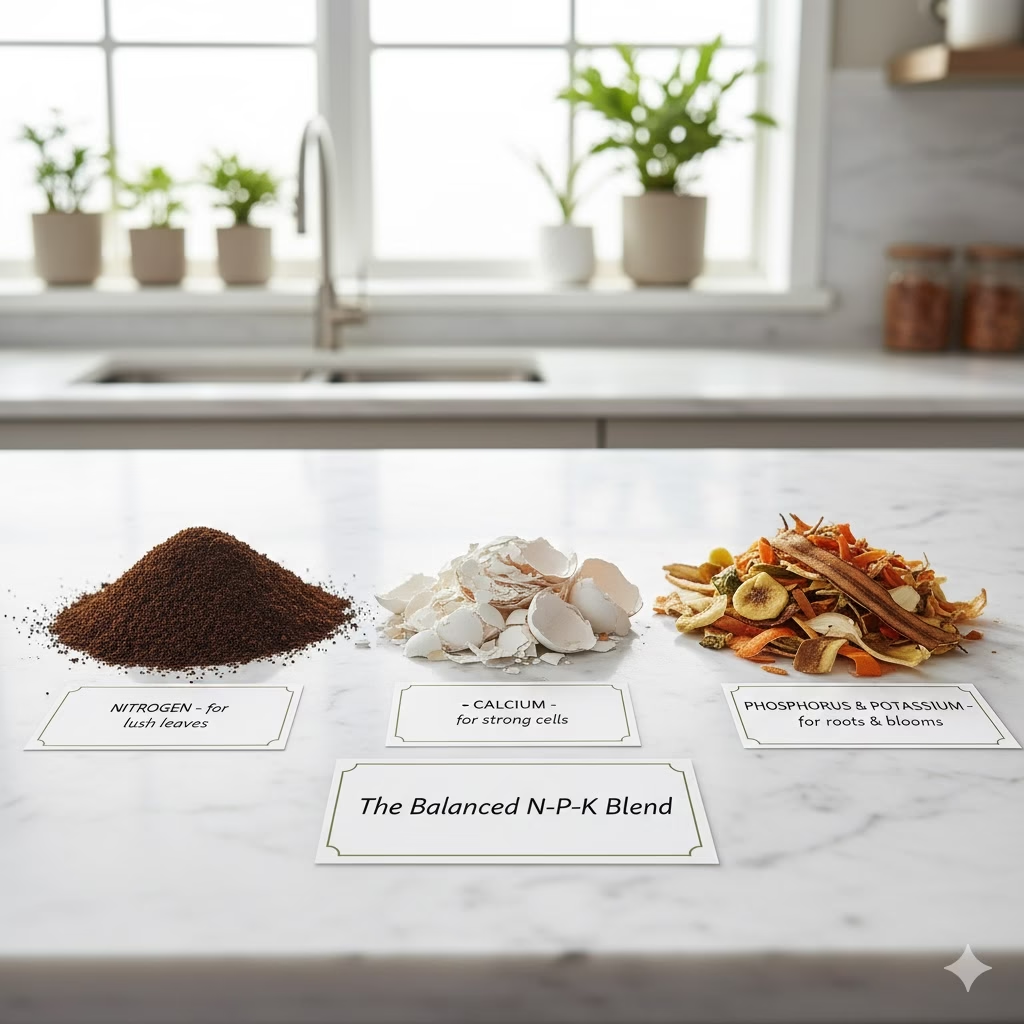
Plants rely on three main nutrients, often called NPK:
- N (Nitrogen): This is for leaf and stem growth. Coffee grounds are a great source.
- P (Phosphorus): This is for root and bloom growth. Potato and carrot peels help here.
- K (Potassium): This is for overall plant health and water regulation. Banana peels are the winner here.
By mixing coffee grounds, banana peels, and vegetable skins, you create a powerful, balanced Fruit and Veggie Fertilizer blend.
Key Tips and Troubleshooting for Fruit and Veggie Fertilizers
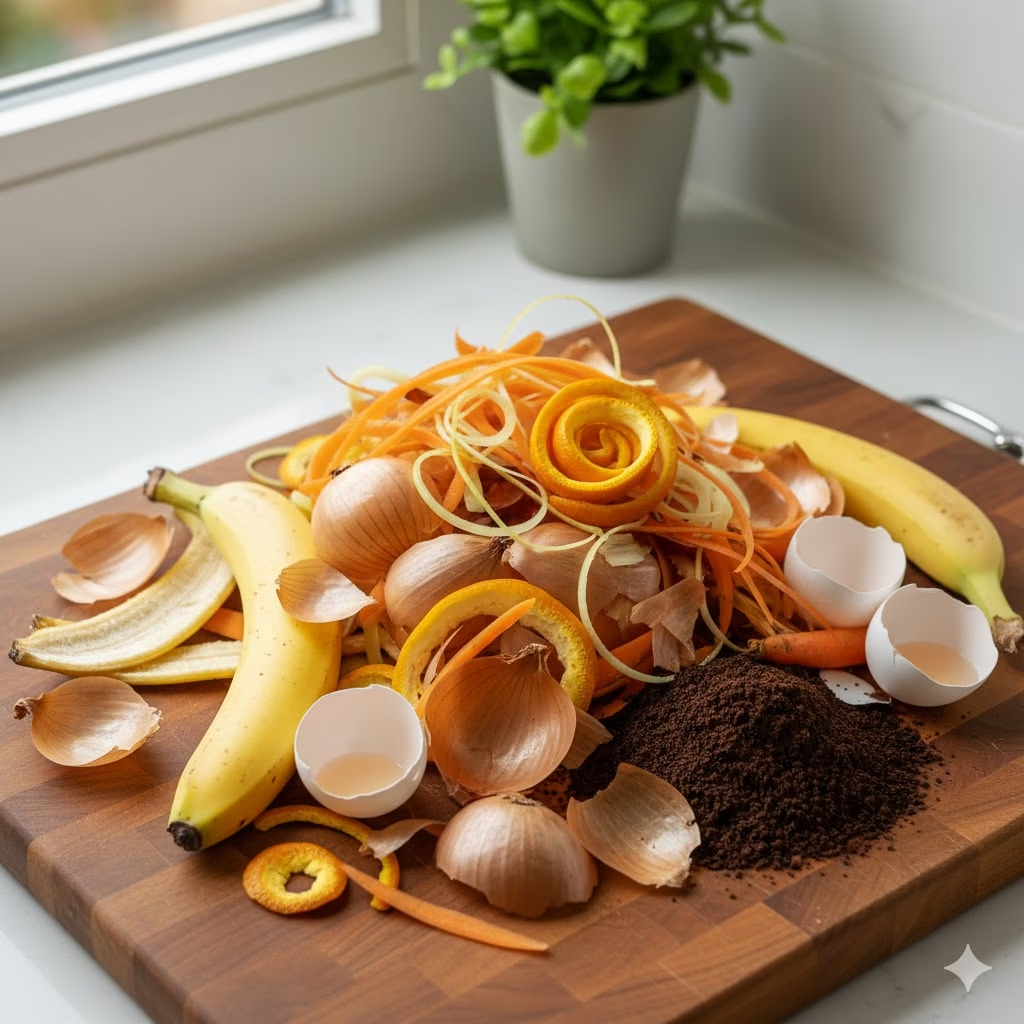
Follow these simple rules to make sure your plants love your homemade Fruit and Veggie Fertilizers and to maintain a clean zero waste home.
1. Safety and Testing
- Start Small and Observe: Always test new fertilizer on one plant first. If leaves turn yellow or get brown edges (signs of burn), your liquid was too strong. Dilute it more next time.
- Mix Scraps: Never use just one scrap type in large amounts. Variety is the key to a balanced diet for your plants.
- Avoid Salt and Sugar: Never use water that had salt in it. Salt kills plant roots. Also, avoid adding sugar, which only feeds bad mold and pests.
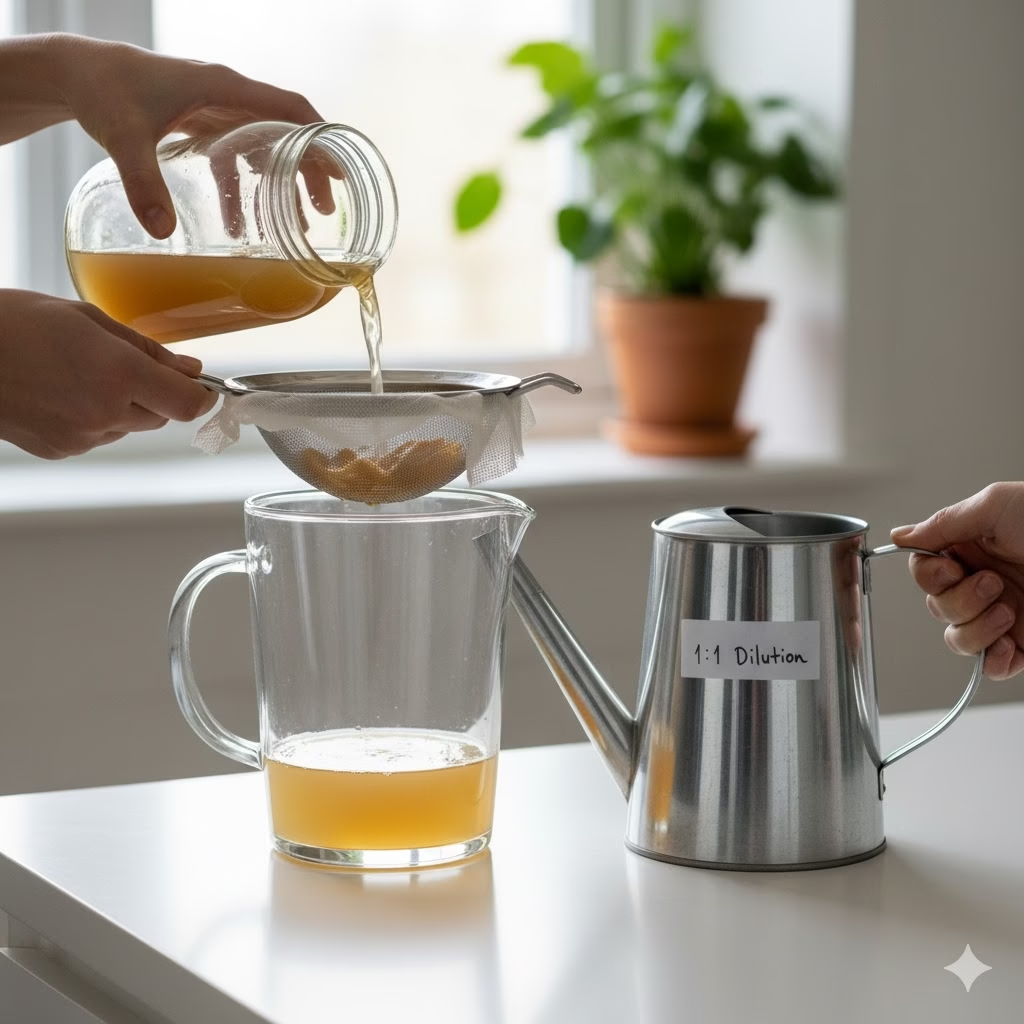
2. Troubleshooting Issues
- Mold on Soil: If you see white or gray mold after using the dried powder, you didn’t dry the peels enough. Carefully scoop out the affected soil and re-top-dress with fresh, completely dry powder.
- Pests (Gnats): If pests appear after watering with the tea, the tea was likely left soaking for too long and started to ferment or spoil. Ensure you use the tea within the 48-hour window.
3. Timing and Dormancy
- Active Season: Only fertilize when your plant is actively growing (usually spring and summer).
- Dormancy: Stop fertilizing completely in the late fall and winter. Plants slow down and don’t need the extra food. Giving them fertilizer when they are dormant can actually harm them by promoting weak growth.
Use these zero-waste tips to help your plants grow strong and lush. By turning your kitchen scraps into powerful Fruit and Veggie Fertilizers, you can enjoy a beautiful, thriving indoor garden while keeping your trash can empty.
References
- Universityofconnecticut – Houseplant Fertilization
- RuralSprout – Banana Peel Fertilizer + 9 More Banana Peel Garden Uses
Recent Posts

